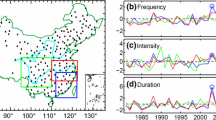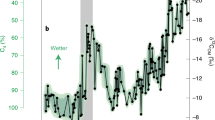Abstract
We examine the spatial and temporal evolution of heat waves through California and consider one of the key modulating factors of summertime coastal climate—coastal low cloudiness (CLC). Heat waves are defined relative to daytime maximum temperature (Tmax) anomalies after removing local seasonality and capture unseasonably warm events during May—September. California is home to several diverse climate regions and characteristics of extreme heat events are also variable throughout these regions. Heat wave events tend to be shorter, but more anomalously intense along the coast. Heat waves typically impact both coastal and inland regions, although there is more propensity towards coastally trapped events. Most heat waves with a strong impact across regions start at the coast, proceed inland, and weaken at the coast before letting up inland. Typically, the beginning of coastal heat waves are associated with a loss of CLC, followed by a strong rebound of CLC starting close to the peak in heat wave intensity. The degree to which an inland heat wave is expressed at the coast is associated with the presence of these low clouds. Inland heat waves that have very little expression at the coast tend to have CLC present and an elevated inversion base height compared with other heat waves.












Similar content being viewed by others
References
Basu R, Samet JM (2002) Relation between elevated ambient temperature and mortality: A review of the epidemiological evidence. Epidemiol Rev 24:190–202
Clemesha RES, Gershunov A, Iacobellis SF, Williams AP, Cayan DR (2016) The northward march of summer low cloudiness along the California coast. Geophys Res Lett. doi:10.1002/2015GL067081
Clemesha RES, Gershunov A, Iacobellis SF, Cayan DR (2017) Daily variability of California coastal low cloudiness: a balancing act between stability and subsidence. Geophys Res Lett. doi:10.1002/2017GL073075
Ebi KL, Teisberg TJ, Kalkstein LS, Robinson L, Weiher RF (2004) Heat watch/warning systems save lives: estimated costs and benefits for Philadelphia 1995–98. Bull Am Meteor Soc 85:1067–1073
Gershunov A, Guirguis K (2012) California heat waves in the present and future. Geophys Res Lett 39:L18710. doi:10.1029/2012GL052979
Gershunov A, Cayan D, Iacobellis S (2009) The great 2006 heat wave over California and Nevada: signal of an increasing trend. J Clim 22:6181–6203. doi:10.1175/2009JCLI2465.1
Grotjahn R, Faure G (2008) Composite predictor maps of extraordinary weather events in the Sacramento, California, region. Weather Forecast 23(3):313–335
Grotjahn R, Black R, Leung R, Wehner MF, Barlow M, Bosilovich M, Lee YY (2016) North American extreme temperature events and related large scale meteorological patterns: a review of statistical methods, dynamics, modeling, and trends. Clim Dyn 46(3–4):1151–1184
Guirguis K, Gershunov A, Tardy A, Basu R (2014) The impact of recent heat waves on human health in California. J Appl Meteorol Climatol 53(1):3–19. doi:10.1175/JAMC-D-13-0130.1
Guirguis K, Gershunov A, Cayan DR, Pierce DW (2017) Heat wave probability in the changing climate of the Southwest US. Clim Dyn. doi:10.1007/s00382-017-3850-3 (in press)
Guzman-Morales J, Gershunov A, Theiss J, Li H, Cayan D (2016) Santa Ana Winds of Southern California: Their climatology, extremes, and behavior spanning six and a half decades. Geophys Res Lett 43:2827–2834. doi:10.1002/2016GL067887
Iacobellis SF, Cayan DR (2013) The variability of California summertime marine stratus: impacts on surface air temperatures. J Geophys Res Atmos 118:9105–9122. doi:10.1002/jgrd.50652
Iacobellis SF, Cayan DR, Norris JR, Kanamitsu M (2010) Impact of climate change on the frequency and intensity of low-level temperature inversions in California. Final Report to the California Air Resources Board Project 06-319. http://www.arb.ca.gov/research/apr/past/06-319.pdf
Kalnay E et al (1996) The NCEP/NCAR 40-year reanalysis project. Bull Am Meteorol Soc 77(3):437–471
Klein SA, Hartmann DL, Norris JR (1995) On the relationships among low-cloud structure, sea surface temperature, and atmospheric circulation in the summertime northeast Pacific. J Clim 8(5):1140–1155. doi:10.1175/1520-0442
Knowlton K, Rotkin-Ellman M, King G, Margolis HG, Smith D, Solomon G, Trent, English P (2009) The 2006 California heat wave: impacts on hospitalizations and emergency department visits. Env Health Persp 117:61–67
Koračin D, Leipper DF, Lewis JM (2005) Modeling sea fog on the US California coast during a hot spell event. Geofizika 22(1):59–82
Leipper DF (1994) Fog on the United States West Coast: a review. Bull Am Meteorol Soc 75:229–240
Lewis J, Koračin D, Rabin R, Businger J (2003). Sea fog off the California coast: Viewed in the context of transient weather systems. J Geophy Res Atmos 108(D15)
Maurer EP, Wood AW, Adam JC, Lettenmaier DP, Nijssen B (2002) A long-term hydrologically-based data set of land surface fluxes and states for the conterminous United States. J Clim 15:3237–3251. doi:10.1175/1520-0442(2002)015<3237:ALTHBD>2.0.CO;2
Myers TA, Norris JR (2013) Observational evidence that enhanced subsidence reduces subtropical marine boundary layer cloudiness. J Clim 26(19):7507–7524
National Weather Service (2012) Heat: a major killer. (http://www.nws.noaa.gov/os/heat/index.shtml
O’Brien TA (2011) The recent past and possible future decline of California coastal fog, Doctoral thesis, p 193, Univ. of Calif., Santa Cruz, Calif
O’Brien TA, Sloan LC, Chuang PY, Faloona IC, Johnstone JA (2012). Multidecadal simulation of coastal fog with a regional climate model. Clim Dyn 1–12
Ostro BD, Roth LA, Green RS, Basu R (2009) Estimating the mortality effect of the July 2006 California heat wave. Environ Res 109:614–619
Qu X, Hall A, Klein SA, Caldwell PM (2014) On the spread of changes in marine low cloud cover in climate model simulations of the 21st century. Clim Dyn 42(9–10):2603–2626. doi:10.1007/s00382-013-1945-z
Schwartz RE, Gershunov A, Iacobellis SF, Cayan DR (2014) North American west coast summer low cloudiness: broadscale variability associated with sea surface temperature. Geophys Res Lett 41:3307–3314. doi:10.1002/2014GL059825
Small I (2006) Forecasters handbook for extreme southwest california based on short term climatological approximations Part 1—The marine layer and its effects on precipitation and heating, NOAA Technical Memorandum NWS WR-277
Williams AP, Schwartz RE, Iacobellis S, Seager R, Cook BI, Still CJ, Husak G, Michaelsen J (2015) Urbanization causes increased cloud base height and decreased fog in coastal Southern California. Geophys Res Lett. 42. doi:10.1002/2015GL063266
Zhong X, Sahu DK, Kleissl J (2017) WRF inversion base height ensembles for simulating marine boundary layer stratocumulus. Sol Energy 146:50–64. doi:10.1016/j.solener.2017.02.021
Acknowledgements
We are thankful for support from NOAA Coastal and Ocean Climate Applications (COCA) program grant NA15OAR4310114. This study supports the climate science education efforts of Climate Education Partners, a project funded by a National Science Foundation Grant #DUE-1239797. The study also contributes to DOI’s Southwest Climate Science Center activities and to NOAA’s California and Nevada Applications Program. NCEP Reanalysis data are provided by the NOAA/OAR/ESRL PSD, Boulder, Colorado, USA, from their website at esrl.noaa.gov/psd. Radiosonde Database at esrl.noaa.gov/ raobs/.
Author information
Authors and Affiliations
Corresponding author
Electronic supplementary material
Below is the link to the electronic supplementary material.
Fig. S1
As in Fig. 3 showing the May 2008 case study but showing maps (top) using HWI_raw. Also, CLC for north (N) and South (S) are shown in the regional time series. Supplementary material 5 (PDF 204 KB)
Fig. S2
1960 Case Study. 2nd strongest Central Valley heat wave event, but cloudy and protected from the heat wave at the South Coast. Traces show ZBASE (black), CLC (gray), and regional HWI (colors). Supplementary material 6 (PDF 103 KB)
Rights and permissions
About this article
Cite this article
Clemesha, R.E.S., Guirguis, K., Gershunov, A. et al. California heat waves: their spatial evolution, variation, and coastal modulation by low clouds. Clim Dyn 50, 4285–4301 (2018). https://doi.org/10.1007/s00382-017-3875-7
Received:
Accepted:
Published:
Issue Date:
DOI: https://doi.org/10.1007/s00382-017-3875-7




